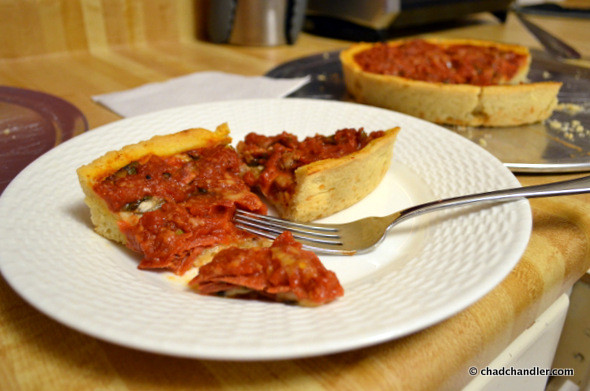
I’ve never been a huge fan of Chicago-style deep dish pizza. That’s not to say I dislike it. I get the itch to have it every so often for variety’s sake. Work seems to take me to Chicago occasionally, so I get to scratch that itch every few years. Lately I’ve been craving a slice of the deep stuff, and to my genuine surprise there’s not a single place that serves Chicago-style deep dish pizza in Greenville, SC.
I’ve written before that there is no great pizza in Greenville. That’s why I built my DIY pizza oven. I mentioned this to someone at work (I commute to Clemson) not too long ago and she said, “there’s a place just down the street that does deep dish.”
I was surprised, so I checked the restaurant’s website. Sure enough, the restaurant’s marketing angle seems to pit NY- against Chicago-style pizzas. I dropped in for lunch last Friday and was happy to see that they indeed offered both styles of pizza on their menu.
“A small sausage and peppers deep dish pizza, please,” I told the waitress. I looked around, but no one seemed to be eating deep dish. “I guess NY wins,” I mumbled to myself.
I settled into my booth, expecting to wait at least half an hour for my lunch. When the pizza came out in ten minutes, it was the second biggest surprise of the meal. The biggest surprise was that my meal wasn’t Chicago-style deep dish pizza at all.
“Excuse me,” I politely said to the waitress. “I think I ordered deep dish?” She looked at me with condescending bemusement and replied, “that is the deep dish.”
She had served me a standard pan pizza. This is what Pizza Hut made famous in the ’80s. It’s basically just a puffier NY-style pizza. I am not a fan of pan pizza. Why would you take the most boring part of a pizza—the crust—and make it 3/4 of every bite? It never made sense to me. I ate a couple of pieces and left. I was back at square one.
As so often happens, the best solution was for me to just do it myself.
Making Deep Dish At Home
When you think of Chicago-style deep dish pizza, two varieties come to mind:
- Standard deep: oiled pan, then dough, then cheese, then toppings, then sauce
- Giordano’s-style stuffed crust: oiled pan, then dough, then cheese, then toppings, then dough, then sauce
I decided I wanted to make a clone of Lou Malnati’s pizza (video), so I went with variety #1. There’s really not much to this if you know how to work with dough. I doubled this recipe from the pizzamaking.com forums to make two dough balls. If you don’t have a kitchen scale, there are conversions at the link.
Lou Malnati’s Copycat Crust
- Flour (100%): 195 grams all-purpose unbleached (plus 8 grams semolina)
- Water (47%): 95 grams
- Active dry yeast (.7%): 2 grams
- Olive oil (6%): 12 grams
- Corn oil (18.5%): 38 grams
- Butter (1%): 2 grams
- Sugar (1.5%): 3 grams
- Kosher salt: 2 grams
Sift the all purpose and semolina flour to remove any lumps. Add salt, butter, and oils to the flour and combine with a spoon. Heat the water to 110°F. Dissolve the sugar in the water and sprinkle the yeast on top. Allow the yeast to activate and foam, then add the water/yeast mixture to the flour mixture. Hand mix with spoon for about 30 seconds. The mixture should form a sticky ball (if it’s too sticky to ball up, add more flour). Knead on a floured work surface for exactly 1 minute. Place the dough ball into an oiled bowl, cover with foil, and put into a 95° oven for 2½ hours (I just heat the oven on the lowest setting for a minute and then turn it off). Remove the dough, punch it down, and let it rest on the counter for another 1½ hours.
Here’s what the dough looks like when it’s punched down after rising in the oven.

Punch it down again before pressing it into the pan. I used two 9″ cake pans greased with olive oil and lightly sprinkled with Parmesan cheese.
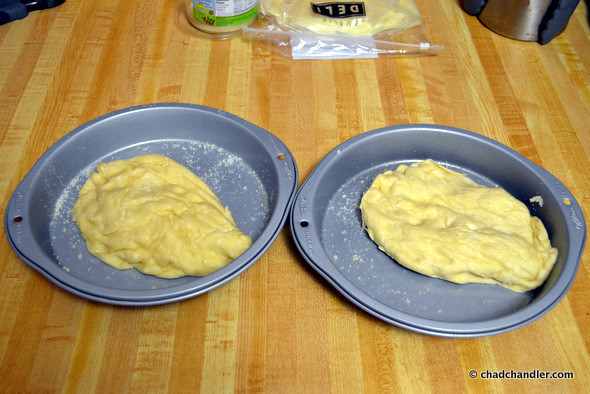
Press the dough flat (less than 1/4″) in the pan and use your fingers to squeeze the dough up the sides.
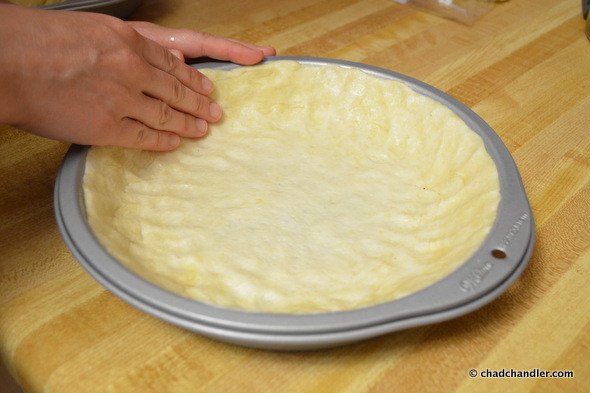
I pre-cook my pizza toppings (but not the mushrooms) to cut the grease. Most places in Chicago don’t do this, but I have to please the wife.

Assemble the pizzas. The first layer is sliced mozzarella cheese. These pies had 1/4 pound of cheese each. Then you add the toppings. I made two pies: one with pepperoni, mushrooms, and basil, and another with Italian sausage, onions, and peppers.
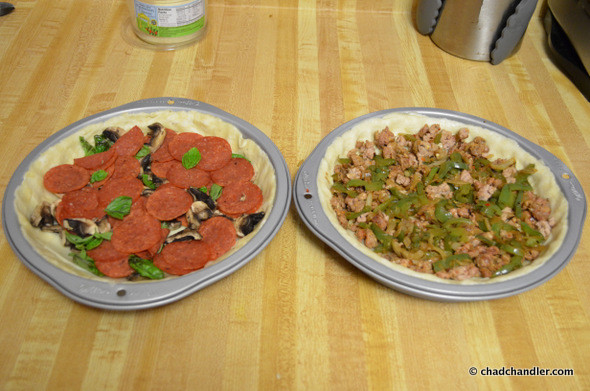
The sauce is just a can of crushed San Marzano tomatoes. I simmered the sauce for a minute to infuse a little basil and crushed red pepper. Most places don’t cook their sauce, but it’s necessary for me to replicate the flavor. If you can find the 6 in 1 brand of crushed tomatoes, it’s supposed to be right on the money.
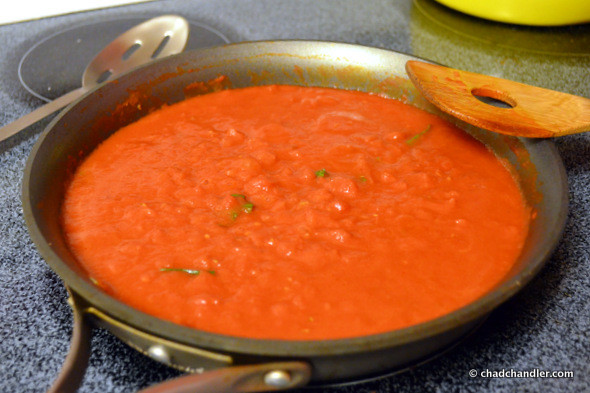
Spoon the tomatoes over the toppings in an even layer. I used a slotted spoon to avoid a watery sauce.
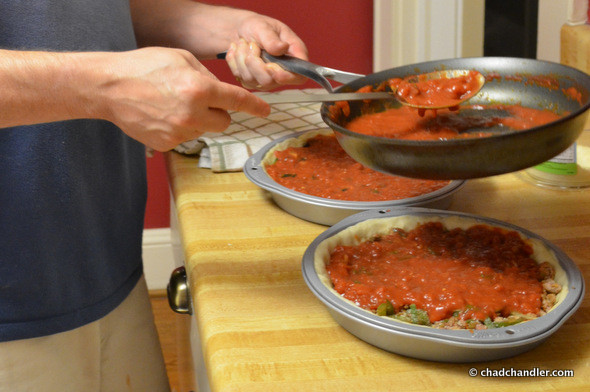
Finally, top with some finely grated Parmigiano-Reggiano cheese.
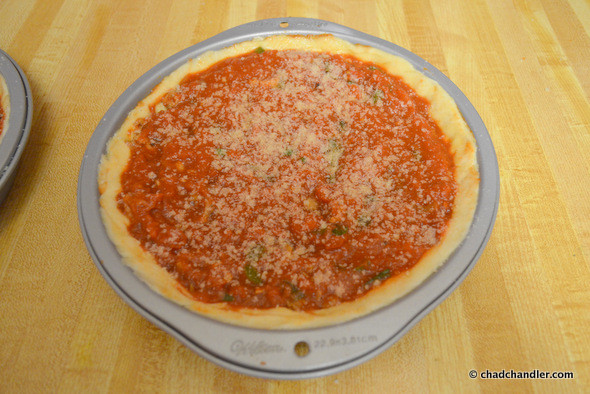
Bake uncovered at 425°F for 25–30 minutes, depending on how brown the crust gets. You want light brown but not burnt. This is what it looks like when it’s done. If I had used a black pan, I would have gotten a slightly darker crust.
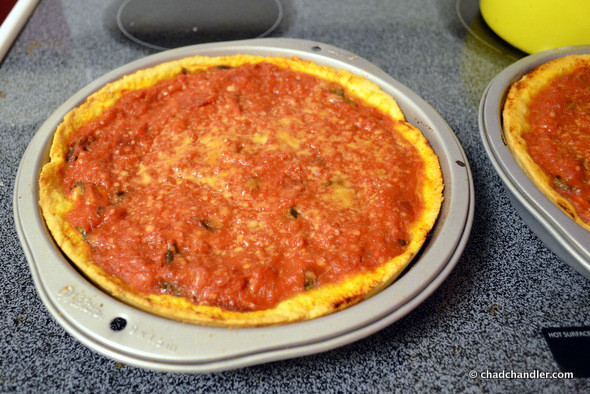
The crust came out perfect. That’s the hard thing to get right, but this recipe makes a clone of the best Chicago crust. It’s light, flaky, and buttery, yet strong enough to hold the heavy pie together.
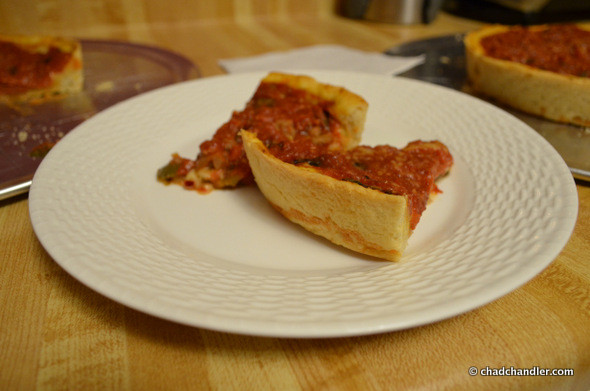
I could have pressed the dough into the corners a little better. Here’s the pepperoni, mushroom, and basil pizza.
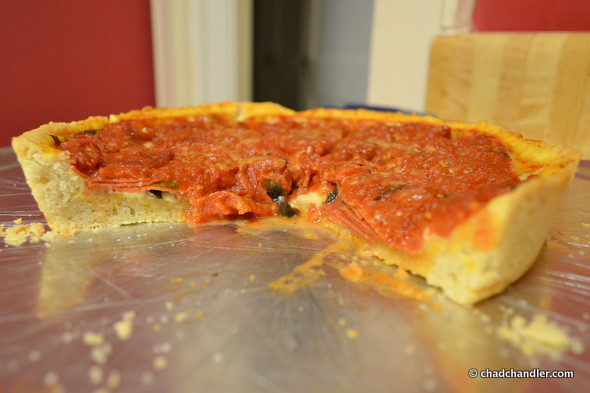
This is the one with Italian sausage, onions, and peppers.

You can see the cheese oozing out of the pizza here. Even though I used what I consider to be a lot, I would double the amount to 1/2 pound of cheese per pie next time.

I think I might plan a dinner where I cook Neapolitan, NY-, and Chicago-style pizzas and let the guests vote on their favorite.






